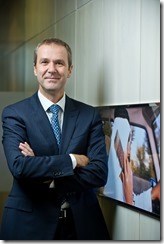Ericsson has conducted research into what are the recurring characteristics of successful global telecom operators, and has devised six ‘growth codes’ that it believes service providers can implement in order to consolidate their development and market positions. Anders Lindblad, Ericsson’s president for the Middle East, details Ericsson’s outlook
Anders Lindblad says that operators that have learnt to maximise returns from broadband network investments are typically the ones leading their respective markets
A study conducted by Ericsson identifies a number of characteristics that leading global telecom operators share in common, and the company believes these to be solid indicators that service providers are undertaking the right strategies in today’s broadband-centric telecom sector.
Operators in this leading category have been enjoying double-digit revenue growth since 2009, according to Anders Lindblad, Ericsson’s president for the Middle East. There has also been growth in these operators’ profitability, and they tend to be the most profitable operators in their respective markets.
“The third success characteristic is that these operators tend to have their businesses being driven by mobile broadband services,” Lindblad added.
In order to achieve these successes, Ericsson has identified six what it calls growth codes, which if implemented, are likely to drive service providers’ ambitions to generate more revenue and grow their operating margins.
Gap minding is the first such behaviour Ericsson has identified, and relates to leading operators betting their capex on large gaps in quality, experience, and value; rather than small gaps of price, and thereby steering clear of detrimental price wars, and instead inspire new demand. The large gaps could relate to areas such as being a tech pioneer and being first-to-market; broad network coverage; performance excellence; or device offering.
“The second growth code relates to streetwise metrics, which involves the creation of feedback loops between the actual customer experience and network performance, with the view to improving overall customer experience,” Lindblad said.
Show-casing is the third area, and relates to making ideas relevant and proving service superiority in ways that people can relate to. AT&T in the US for example, devised a whole campaign around the ability to hold a voice conversation while using a smartphone during a data session; which was functionality that until then had not been possible.
The fourth growth code identified by Ericsson is unboxing, which relates to matching the time consumers spend on the phone with what they actually end up paying for. In many cases there is a mismatch between what customers consume and what they pay for, and Ericsson believes the delivery of tailored offerings and smart tiering solutions creates a more aligned subscription system.
“Frontrunner operators are ecosystematic, which means they are open to collaboration with third-parties, and operate in an open manner that encourages cooperation to the benefit of both parties,” Lindblad explained.
The sixth and last growth code is co-partnering as related to the establishment of long-term relationships with strategic vendors. Such arrangements tend to result in a strong working relationship being forged between the parties, which can then be translated into efficient R&D and other areas.





0 comments ↓
There are no comments yet...Kick things off by filling out the form below.
Leave a Comment